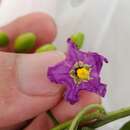Comments
provided by eFloras
Solanum septemlobum var. indutum Handel-Mazzetti (Oesterr. Bot. Z. 83: 234. 1934) was distinguished by being densely covered overall with capitate glandular hairs of varying length, but this condition sometimes occurs in more or less typical material of S. septemlobum. Without seeing the type material, which was collected in S Shaanxi, the identity of this variety remains uncertain.
- license
- cc-by-nc-sa-3.0
- copyright
- Missouri Botanical Garden, 4344 Shaw Boulevard, St. Louis, MO, 63110 USA
Description
provided by eFloras
Herbs or shrubs, erect, unarmed; pubescence of curved simple, often glandular hairs. Stems angular, usually white pubescent, sometimes glabrescent. Petiole 1-2.5 cm; leaf blade ovate, 3-9 × 2-6 cm, base cuneate, usually 3-7-parted, sometimes upper leaves subentire, apex obtuse; lobes ovate-oblong to lanceolate, sparsely pubescent, entire or dentate. Inflorescences extra-axillary or appearing terminal, open panicles; peduncle 2-5 cm, puberulent or glabrous. Pedicel 5-10 mm, usually basally articulated. Calyx ca. 2 mm in diam., sparsely pubescent abaxially; lobes deltate, 0.5-1 mm. Corolla greenish purple, 8-10 × 8-10 mm, 5-parted; lobes oblong-ovate, 4-6 mm, pubescent, ciliate, reflexed. Filaments ca. 1 mm; anthers oblong, 2.5-3.5 mm. Style ca. 7 mm. Berry red, subglobose or ovoid, ca. 8 mm in diam. Seeds discoid, 2-3 mm in diam. Fl. Jun-Oct, fr. Oct-Dec.
- license
- cc-by-nc-sa-3.0
- copyright
- Missouri Botanical Garden, 4344 Shaw Boulevard, St. Louis, MO, 63110 USA
Distribution
provided by eFloras
Anhui, Gansu, Hebei, Henan, Jiangsu, Liaoning, Nei Mongol, Shaanxi, Shandong, Shanxi, Sichuan, Xinjiang, E Xizang, Zhejiang [Russia]
- license
- cc-by-nc-sa-3.0
- copyright
- Missouri Botanical Garden, 4344 Shaw Boulevard, St. Louis, MO, 63110 USA
Habitat
provided by eFloras
Sunny slopes; 300-2500 m.
- license
- cc-by-nc-sa-3.0
- copyright
- Missouri Botanical Garden, 4344 Shaw Boulevard, St. Louis, MO, 63110 USA
Synonym
provided by eFloras
Solanum septemlobum var. ovoideocarpum C. Y. Wu & S. C. Huang; S. septemlobum var. subintegrifolium C. Y. Wu & S. C. Huang.
- license
- cc-by-nc-sa-3.0
- copyright
- Missouri Botanical Garden, 4344 Shaw Boulevard, St. Louis, MO, 63110 USA
Description
provided by Phytokeys (archived)
Woody vine or lax shrub, to several meters long. Stems slightly winged, sparsely to densely pubescent with white, curved, simple uniseriate trichomes to 0.5 mm long, these appressed and all pointing apically, with 4–6 small cells; new growth densely white pubescent with simple uniseriate curved trichomes to 0.5 mm long. Bark of older stems pale brown, glabrescent. Sympodial units plurifoliate. Leaves simple or more commonly variously pinnatifid and lobed, extremely variable in shape and size, (1-)2–9(-10) cm long, (0.9-)1.2–5 (-8) cm wide, ovate in outline, widest in the basal third of the blade, the upper and lower surfaces sparsely to moderately pubescent with simple uniseriate trichomes to 1 mm long like those of the stems, all pointing to the margins (away from the axis); base truncate, then attenuate onto the petiole; margins entire to deeply lobed with 1–4 pairs of lobes to within 1 mm of the midrib, the lobbing irregular towards the leaf apex; apex acute, rounded or if acuminate, the ultimate tip rounded; petiole 0.5–3 cm long, sparsely to densely pubescent like the stems. Inflorescences terminal or lateral, 2.5–16 cm long, open and many times branched, with 10–40 flowers, sparsely pubescent with simple white trichomes like those of the stems, these curved and pointing towards the tip of the inflorescence; peduncle 1–5 cm long; pedicels 7–10 mm long, ca. 0.5 mm in diameter at the base, ca. 1 mm in diameter at the apex, slender, spreading, glabrous, articulated at the base, leaving a small peg to 1 mm long on the inflorescence axis; pedicel scars irregularly spaced 1–10 m apart, closer towards the distal part of the inflorescence. Buds ellipsoid, the corolla strongly exserted from the calyx tube before anthesis. Flowers all perfect, 5-merous. Calyx tube 1–1.5 mm long, conical, the lobes 0.5–1.5 mm long, broadly deltate, the margins usually thickened and white in dry material, glabrous or with a few white, uniseriate curved trichomes. Corolla ca. 2 cm in diameter, violet with a green eye, this whitish green or brown in dry material, stellate to broadly stellate, lobed 1/2 to 2/3 of the way to the base, the lobes 4–6 mm long, 1.5–4 mm wide, reflexed to spreading at anthesis, glabrous, minutely papillate on the tips. Filament tube ca. 0.5 mm long, the free portion of the filaments ca. 1 mm long, glabrous or pubescent with a few weak uniseriate simple trichomes in the sinuses; anthers 3–4 mm long, ca. 1 mm wide, loosely connivent, ellipsoid, poricidal at the tips, the pores lengthening to slits with age. Ovary glabrous; style 4.5–7.5 mm long, glabrous; stigma capitate, minutely papillate, green or white in living material. Fruit a globose or slightly ovate berry, 0.8–1 cm wide, 1–1.2 cm long, bright red when ripe, the pericarp thin and shiny, glabrous; fruiting pedicels 0.8–1.3 cm long, ca. 1 mm in diameter, not particularly woody, spreading. Seeds > 20 per berry, ca. 3 mm long, ca. 2 mm wide, flattened reniform, pale yellowish tan or yellow, the surfaces minutely pitted, the mature seeds appearing pubescent with the elongate lateral cell walls ca. 0.2 mm long, the pitted bases still visible. Chromosome number: not known.
- bibliographic citation
- Knapp S (2013) A revision of the Dulcamaroid Clade of Solanum L. (Solanaceae) PhytoKeys 22: 1–432
- author
- Sandra Knapp
Distribution
provided by Phytokeys (archived)
(Figure 90). Solanum septemlobum is a boreal species in China, from sea level to 1200 m; it perhaps extends to adjacent Mongolia but all specimens seen so far are from the Chinese Autonomous Region of Nei Mongol, previously known as “Inner Mongolia”. Its southerly distribution overlaps with Solanum pittosporifolium, from which it is sometimes difficult to distinguish.
- bibliographic citation
- Knapp S (2013) A revision of the Dulcamaroid Clade of Solanum L. (Solanaceae) PhytoKeys 22: 1–432
- author
- Sandra Knapp

